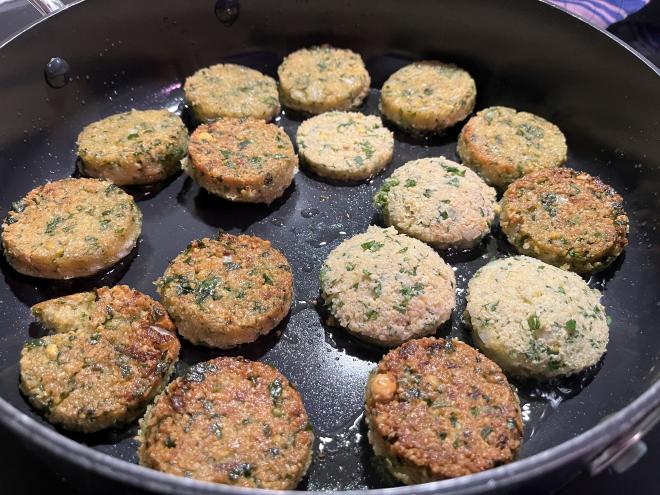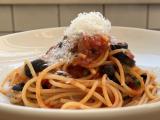Falafel
Table of Contents
Jump to Recipe
Jump to Carbon Footprint
There is exactly one recipe where I know by heart on which page I can find it in the cookbook: It’s the falafel recipe from Yotam Ottolenghi’s and Sami Tamimi’s “Jerusalem” cookbook (in case you wondered: page 99, at least in the German edition 🤓 ; publisher’s website). It’s probably the page with the most stains in our cookbook collection, partly because we’ve made it so many times, but also because the chickpea batter tends to fly around the kitchen if you’re not careful with the food processor.
Falafel is actually very simple, but incredibly delicious: at its core is a dough made from chickpeas and a little flour with various spices and herbs. While the chickpeas provide a good base, the herbs add a light freshness: Baked or fried, they are a quick meal on the go, whether as a late-night snack or as a comfort food at home.

With this recipe you can easily make your own falafel. We make falafel so often that over the years we have started to optimise the process. That’s why, in our almost vegetarian household, we have a meat grinder, which has never actually been used for processing meat and which we bought especially for falafel: It makes the falafel mixture nice and homogeneous and prevents the dough from flying around the kitchen if you lift the food processor too quickly. We also got a falafel scoop from friends some time ago (it looks something like this). This makes it very easy to make compact falafel that are all exactly the same size.
Of course, you can also make falafel with tinned chickpeas, but in this recipe we use dried chickpeas that have been soaked in water overnight. They don’t need to be cooked before we make them into falafel: If you soak them the night before, they’re ready.
I like to serve the falafel with flatbread, some fresh vegetables and tahina - a sesame oil sauce with a great, slightly bitter flavour. To balance the fat in the falafel, it needs a little acidity - for example, pickled salted lemons, a few thin slices of pickled gherkin or simply lemon juice. My personal insider tip is to add a touch of tahini - an oriental sauce made from sesame seeds and oil, which adds a pleasantly light bitterness.
Recipe #
Falafel
60 minutes
about 12 balls (for 2 people)
Ingredients #
For the falafel #
- 150 g dried chickpeas (alternatively: 300 g tinned chickpeas)
- 1 small onion (approx. 50 g)
- 1 clove of garlic
- 1 teaspoon fresh parsley
- 1.5 teaspoons fresh coriander
- 1 pinch of cayenne pepper
- 1 pinch of cumin / cumin seeds
- 1 pinch of coriander
- 1 pinch of cardamom
- 1 pinch of salt
- 2 g baking powder
- 1 tablespoon flour (approx. 15 g)
- optional: 1 teaspoon sesame seeds
- for frying: 50 ml oil
Sides and Accompaniments #
- 2 pita breads / flatbreads
- 3-4 lettuce leaves
- a small piece of cucumber
- 1 tomato
- about 2-3 tablespoons of Greek yoghurt or a vegan alternative
- 1/2 teaspoon lemon juice
- optional: 1 tablespoon hummus
- optional: 1 tablespoon tahini
Directions #
- Soak the dried chickpeas overnight in (at least) double the amount of water.
- Peel and chop the onion and garlic. Wash and chop the parsley and coriander. Drain the chickpeas and leave to drain well, then mix with the chopped and diced ingredients.
- Preferably put the chickpeas through a mincer on the finest setting. (If you don’t have a mincer: Add the spices, salt, flour and about 2 tablespoons of water and knead with your hands until you have a smooth dough. When you have enough puff pastry, leave to rest in the fridge for 1 hour.
- Gradually shape the mixture into balls: 1 tablespoon of dough makes about one falafel. The easiest way to do this is with a falafel scoop, or with your hands if necessary. If you like, you can also roll the falafel in sesame seeds. Make sure the balls are compact - otherwise they will fall apart later. If necessary, knead some extra flour and water into the dough. If you want to fry the falafel in a pan, it is best to make flat slices. If you prefer balls, you can deep-fry them, but you will need more oil.
- Heat the oil in a large frying pan and fry the falafel in batches until they are brown and a little crispy on the outside.
- While the falafel are cooking, prepare the side dishes: Wash the lettuce, cucumber and tomato and cut into strips (lettuce) and cubes (cucumber, tomato). Prepare the sauces and warm the flatbread in the oven or toaster. Serve everything together.
Carbon Footprint #
In total, two portions of falafel have an estimated carbon footprint of 793 g.
This ranks it number 6 out of 57 recipes published on the blog so far in terms of estimated carbon footprint.
In other words, it is one of the 10% of recipes with the lowest greenhouse gas impact! 🤩An important factor, of course, is that the chickpeas themselves have a relatively good greenhouse gas balance. The lettuce and the cucumber and tomato on the side also account for around a quarter of the weight of the ingredients, but all have a fairly good carbon footprint overall. On the other hand, three other ingredients stand out:
- The above-average carbon footprint of oil is due to its processing and the disposable glass bottles that are often used as packaging. These are relatively energy-intensive to produce and relatively heavy compared to the content of the packaging itself. In this recipe, we are frying the falafel in a pan - but if you were to deep-fry the falafel instead, you would easily use more than half a litre of oil and therefore have a larger carbon footprint for your recipe.
- Greek yoghurt, of course, is made from milk - and it takes more milk to make than 3.5% yoghurt to achieve the higher fat content. And of course dairy farming is bad for the climate because of the methane cows produce during digestion. 🐮 💨
- Tahina is perhaps a bit of a surprise on this list: It’s basically a relatively simple sauce made from sesame seeds, oil and a bit of salt - but unfortunately, sesame seeds in particular have a surprisingly large carbon footprint (around 6kg of CO2 per kg of sesame seeds, more than double that of Greek yoghurt), and the oil used also contributes significantly to the carbon footprint.
| ingredient | carbon footprint per kg | carbon footprint (in g) for 2 servings | % of ingredients | % of CO2 emissions |
|---|---|---|---|---|
| Chickpeas | 0.7 | 107 | 20% | 13% |
| Onion | 0.2 | 10 | 7% | 1% |
| Garlic | 0.5 | 1 | 0% | 0% |
| Parsley, fresh | 1.0 | 5 | 1% | 1% |
| Coriander, fresh | 1.2 | 9 | 1% | 1% |
| Cayenne pepper | 1.1 | 1 | 0% | 0% |
| Cumin | 1.1 | 1 | 0% | 0% |
| Coriander | 1.1 | 1 | 0% | 0% |
| Cardamom | 1.1 | 1 | 0% | 0% |
| Salt | 0.7 | 1 | 0% | 0% |
| Baking powder | 5.9 | 12 | 0% | 1% |
| Flour | 0.5 | 8 | 2% | 1% |
| Sesame | 6.1 | 30 | 1% | 4% |
| Oil | 3.3 | 165 | 7% | 21% |
| Pita | 0.9 | 172 | 27% | 22% |
| Salad | 0.3 | 9 | 4% | 1% |
| Cucumber | 0.4 | 20 | 7% | 3% |
| Tomato | 0.8 | 80 | 13% | 10% |
| Hummus | 1.0 | 15 | 2% | 2% |
| Greek yoghurt | 2.4 | 98 | 5% | 12% |
| Lemon juice | 0.6 | 3 | 1% | 0% |
| Tahina | 3.0 | 30 | 1% | 4% |
| Fry falafel | 15 | 2% |


